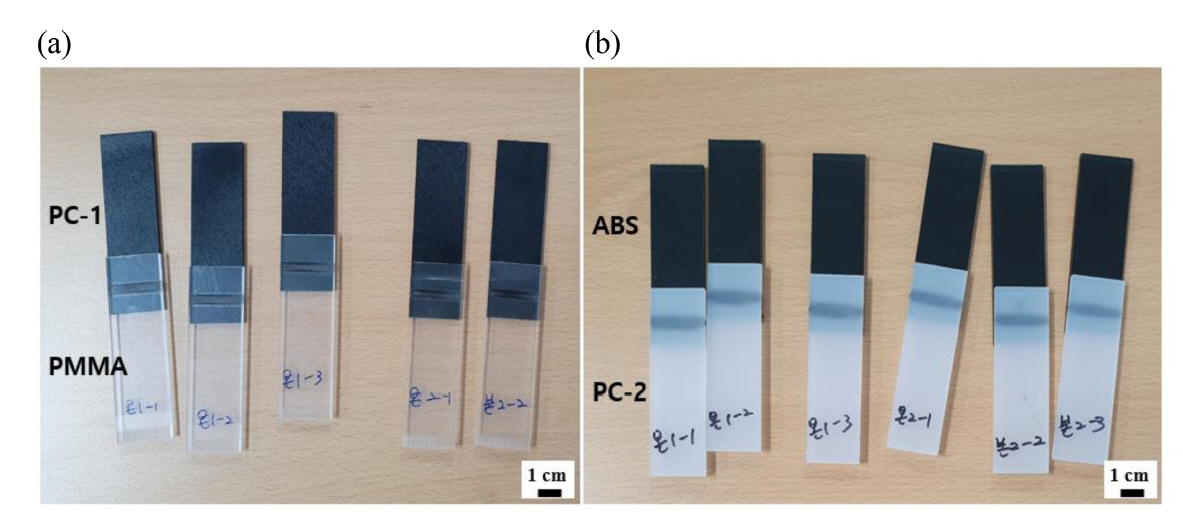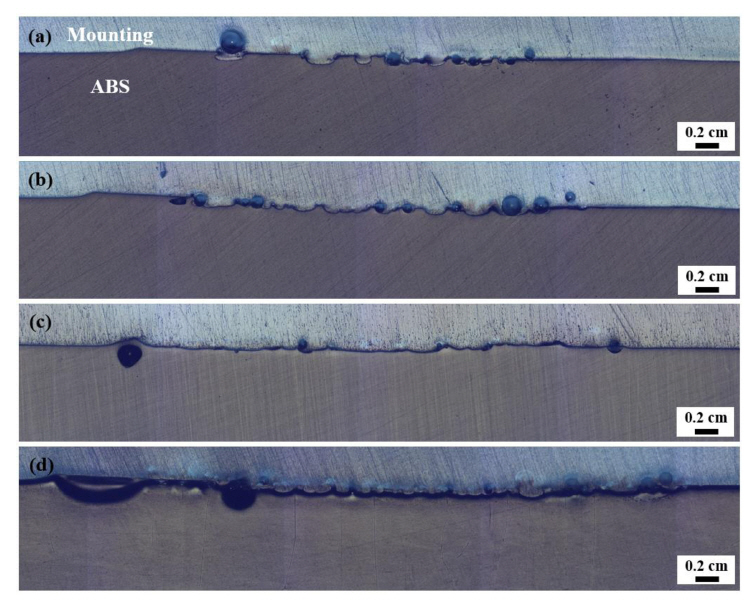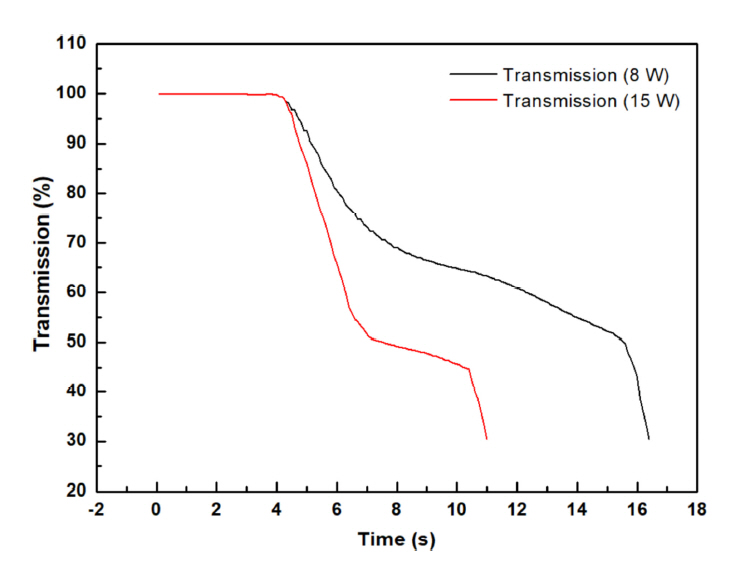1. INTRODUCTION
Multiple countries have initiated or will initiate policy packages to regulate greenhouse gas emissions from passenger cars and light-commercial vehicles [1]. As a result, the demand for eco-friendly vehicles, including electric and hydrogen vehicles, has dramatically increased [2]. One of the biggest challenges for eco-friendly vehicles is finding ways to improve fuel efficiency. Vehicle bodies have traditionally been made primarily of steel, which has high strength and excellent durability, but is also considerably heavy [3]. Therefore, lighter alternatives such as plastics, aluminum alloys, and magnesium alloys have been introduced to reduce the weight of vehicles [4].
The use of plastics has been increasing in automobiles because they provide high strength, low density, low cost, and ease of manufacturing [5]. In particular, plastics have been widely adopted as automotive interior and exterior materials. To achieve both high strength and transparency, plastic components such as dashboards, headlamps, and rear lamps are made of multiple types of plastics. Moreover, plastics are used for packaging various electronics and sensors in automobiles. Generally, the top and bottom plastic parts are joined, and the electronics are located inside the plastics. For example, polycarbonate (PC) and polymethyl methacrylate (PMMA) are used for the headlamp and rear lamp, and multiple halogen lamps or light-emitting diodes (LEDs) are located inside the plastics [6]. To protect the electronics inside the plastics, high joining strength and excellent water tightness of the plastic joining are essential.
Various plastic adhesives based on epoxy, urethane, or methyl methacrylate have been employed for plastic joining. The plastic adhesives are cheap and can be easily applied by low-skilled workers. Moreover, they can be used to join multiple plastic combinations even in high humidity environments. However, the joining strength of the plastic adhesive weakens in high temperature environments. In addition, the solvent-based plastic adhesives cause severe environmental pollution in the manufacturing process, and inhalation of those adhesives can result in a number of respiratory diseases. Therefore, developing eco-friendly joining technologies for plastics has become increasingly important. Laser joining is a promising candidate for the plastics joining because of its characteristics of non-contact, high precision, and easy control [7-12]. For the laser joining of dissimilar plastics, the plastics with high transmission are employed as the top parts, while the plastics with good absorption are adopted as the bottom parts. The laser beam transmitted through the top plastic is applied to the bottom plastic, which raises the interface temperature of the top and bottom plastics to the glass transition temperature. Cross-linking of the top and bottom plastics can be achieved under pressure, resulting in a strong plastic joining [10].
In this study, two different wavelengths of diode lasers were utilized to join dissimilar plastics. The dual laser beam joining was conducted to join two different combinations of plastic joining, under different experimental conditions. Then, the tensile shear force of the plastic joints was examined, and compared with that of a single laser beam joining. Moreover, the temperature and transparency of the top plastic parts were examined during the laser beam application to investigate the mechanism involved in the dual laser beam plastic joining.
2. MATERIALS AND METHODS
2.1 Materials
The commercial polycarbonate-1 (PC-1, Lotte Chemical), polycarbonate-2 (PC-2, Lotte Chemical), polymethyl methacrylate (PMMA, Lotte Chemical), and acrylonitrile butadiene styrene (ABS, Lotte Chemical) were prepared in the dimensions of 23 (width) mm × 78 (length) mm × 2 (thickness) mm, respectively. The chemical compositions of the plastics were analyzed via a CHNS/O elemental analyzer (FlashMart, Thermo Fisher), and the results are summarized in Table 1. The PMMA and PC-2 were utilized for the top plastic parts (i.e., transmission parts), while the PC-1 and ABS were used for the bottom plastic parts (i.e., absorption parts). As a result, dissimilar plastic joints of the PMMA/PC-1 and PC-2/ABS were achieved. Thermogravimetric analysis (TGA, Labsys Evo, Setaram) was conducted under a N2 atmosphere (flow rate of 50 ml/min) from 30 to 600°C to examine the decomposition kinetics of specimens.
2.2 Experimental setup for the dual laser beam plastic joining
Figure 1 (a) presents the experimental setup for the dual laser beam plastic joining. Two different diode lasers with central wavelengths of 980 (ELCR-100, EVlaser) and 1940 nm (ELCR-D102, EVlaser) were employed to join the dissimilar plastics. For the PMMA/PC-1 joint, the laser power with a wavelength of 980 nm was set at 25 W, and the laser powers with a wavelength of 1940 nm were set at 8, 11.5, and 15 W. On the other hand, for the PC-2/ABS joint, the laser power was fixed at 40 W for a wavelength of 980 nm, and the laser powers of 8, 15, and 22 W were used for a wavelength of 1940 nm. The laser parameters and the corresponding specimen’s names are summarized in Table 3.
A customized laser head was mounted on a six-axis multi-joint robot for the laser beam scanning, and the scanning speed was fixed at 20 mm/s. To create an overlap joint, the transparent parts were placed on the absorption parts with an overlap of 15 mm, and the specimens were firmly clamped. Figure 1 (b) and (c) show the dual laser beam plastic joining at the beginning and at the end, respectively.
Figure 2 shows the optical configuration of the customized laser head and final laser beam shape for the dual laser beam plastic joining. The customized laser head consisted of a 980 nm laser beam reflection mirror, 980 nm laser beam reflection and 1940 nm laser beam transmission mirrors, and a 1940 nm laser beam reflection mirror. The laser beam with the Gaussian energy distribution was set at 1.63 and 4 mm for the diode laser with wavelengths of 980 and 1940 nm, respectively, and both laser beams were overlapped, as shown in Figure 2. The 1940 nm laser beam was relatively larger and located in front of the 980 nm laser beam because the 1940 nm laser beam was used to pre-heat the plastics. The surface temperature of the plastics was measured using a two-color pyrometer (LPC03, LASCON, Spectral range: 1.65-2 µm) with a tilt of 45°, which was mounted on the customized laser head. In this study, the surface temperatures of the top plastic parts were measured, because the interface temperature between the two plastic parts could not be measured, due to a limitation of the two-color pyrometer.
2.3 Transmission measurement and joining properties
In order to analyze the cross-section of the plastic joints, these were cut perpendicular to the laser scan direction using a low speed cutting wheel. Then, the cross-sectional macrostructure of the plastic joints was examined utilizing optical microscopy (OM; ECLIPS MA 200, Nikon). The respective transmission values at wavelengths of 980 and 1940 nm were examined for every plastic specimen by measuring the ratio of the transmitted laser beam power to the applied laser beam power. These results are summarized in Table 2. The joining properties of the dissimilar plastic joints (i.e., PMMA/PC-1 and PC-2/ABS) were measured using tensile shear tests (5982 series, INSTRON) at a crosshead speed of 1.3 mm/min. All the tensile shear tests were repeated three times, and the average tensile shear force and standard deviations of tensile shear force were obtained.
3. RESULTS AND DISCUSSION
Figure 3 shows the TGA spectra of the PC-1, PC-2, PMMA, and ABS. For the PMMA and ABS, mass loss began at approximately 90°C, and drastic mass loss was detected at approximately 360°C. For the PC-1 and PC-2, the mass loss appeared at approximately 130°C, and radical mass loss was observed at approximately 440°C. These results indicate that the dual laser beam joining process for the PMMA/PC-1 and PC-2/ABS joints could be conducted in the temperature range of approximately 90-360°C. Figure 4 shows the results of dual laser beam joining for the PMMA/PC-1 (Figure 4 (a)) and PC-2/ABS (Figure 4 (b)) joints with different experimental conditions. Figure 4 shows that the dissimilar plastics joining was successfully achieved with the dual laser beam joining process. The surface temperatures of the top plastic parts were measured to be approximately between 83 and 95°C during the dual laser beam joining of the PMMA/PC-1 (1) and PC-2/ABS (1), respectively. Song et al. [10] also examined the surface temperature of the plastics (i.e., PC and ABS) during dual laser beam joining using a thermal imaging camera, and the measured temperature was found to be approximately 68°C.
Figure 5 shows the cross-sectional OM images of the PC2/ABS joints perpendicular to the laser scan direction. Failure of the plastic joints occurred during sample preparation. Therefore, the OM images only show the cross-section of the ABS (i.e., bottom plastic part). The lengths of joints were measured to be 2.54 cm for the PC-2/ABS (1) (Figure 5 (a)) and 3.47 cm for the PC-2/ABS (2) (Figure 5 (b)). These values increased with increasing 1940 nm laser power, and eventually, the length of joint became 5.62 cm for the PC-2/ABS (4) (Figure 5 (d)) due to the relatively larger laser energy density and laser beam size for the 1940 nm. For the PC-2/ABS (1) and PC-2/ABS (2), embossing surfaces were detected, and those may increase the mechanical anchoring effect at the plastic joints. In contrast, relatively flat surfaces were examined for the PC-2/ABS (3) (Figure 5 (c)) and PC-2/ABS (4). Similar trends were also observed for the PMMA/PC-1 joints.
Figure 6 presents the result of tensile shear tests of the PMMA/PC-1 (Figure 6 (a)) and PC-2/ABS (Figure 6 (b)) joints. For the PMMA/PC-1 joint, the largest tensile shear forces were obtained in the order of the PMMA/PC-1 (2), PMMA/PC-1 (1), PMMA/PC-1 (3), and PMMA/PC-1 (4). For the PC-2/ABS joint, the highest tensile shear forces were examined in the sequence of the PC-2/ABS (2), PC-2/ABS (1), PC-2/ABS (3), and PC-2/ABS (4). For both joints, the largest tensile shear force was obtained with the smallest laser power of the 1940 nm laser beam. The mechanical anchoring effect shown in Figure 5 may increase the tensile shear force. As the laser power of the 1940 nm laser beam increased, the tensile shear force of the joints decreased. As a result, a smaller tensile shear force was obtained compared with that of joints prepared without an application of 1940 nm laser beam. The average tensile shear forces and those standard deviations are listed in Table 4.
The transmission values of the PMMA (Figure 7) and PC2 (Figure 8) were examined with different laser powers. For the PMMA, the transmission values were examined with a laser power of 25 W at a wavelength of 980 nm and 8 W at a wavelength of 1940 nm (Figure 7, black line) and the laser power of 25 W at a wavelength of 980 nm and 15 W at a wavelength of 1940 nm (Figure 7, red line). Without application of the 1940 nm laser beam, the transmission value at a wavelength of 980 nm was 90.9%. This value decreased to 68.8% with the application of the 1940 nm laser beam with a laser power of 8 W. Moreover, the transmission value was found to be 50.8% with the application of the 1940 nm laser beam with a laser power of 15 W. For the PC-2, the measured transmission values were 66.4 and 64.5% for the laser power of 40 W at a wavelength of 980 nm and 8 W at a wavelength of 1940 nm (Figure 8, black line) and the laser power of 40 W at a wavelength of 980 nm and 22 W at a wavelength of 1940 nm (Figure 8, red line), respectively. These values were relatively smaller compared to that without the 1940 nm laser beam (i.e., 70.1%). Geiger et al. [13] also reported that the optical properties of the plastics was strongly dependent on the material temperature, which determined their crystal structure (e.g., amorphous and semicrystalline).
The transmission tests revealed that the application of the 1940 nm laser beam with the 980 nm laser beam increased the absorption of the 980 nm laser beam by the PMMA and PC-2 (i.e., transmission parts). And, this modification of the optical characteristics of the plastics affected the final quality of the dissimilar plastics joining. In the case of the PMMA/PC-1 joint, the average tensile shear force increased from 714.0 to 902.3 N with the application of the 1940 nm laser beam with a laser power of 8 W. However, it decreased to 553.3 and 465.0 N when the laser powers of the 1940 nm laser beam were increased to 11.5 and 15 W, respectively. Because of the high power of the 1940 nm laser, the crystal structure of the transmission part may change from semicrystalline to amorphous, resulting in a decrease in transmission. As a result, the low laser energy of the 980 nm laser beam was applied to the absorption part (i.e., PC-1) because the transmission of the 980 nm laser beam to the transmission part (i.e., PMMA) decreased. As a result, not enough laser energy was applied to the absorption part to achieve good dissimilar plastics joining. Moreover, it is noteworthy that the standard deviation values of tensile shear force increased with larger 1940 nm laser beam power. This result indicates that the non-uniform dissimilar plastics joining was achieved by increasing the 1940 nm laser beam power. For the PC-2/ABS joint, a similar trend was observed with the PMMA/PC-1 joint. However, compared with those of the PMMA/PC-1 joint, only small differences were detected in the average tensile shear force and standard deviation for the PC-2/ABS joint. This may be because only a small variation in transmission values was examined for the PC-2 with the application of different 1940 nm laser beam powers.
4. CONCLUSION
This study employed dual laser beams to join dissimilar plastics. Two laser beams with different wavelengths of 980 and 1940 nm were simultaneously applied to achieve the PMMA/PC-1 and PC-2/ABS joints with various laser parameters. For the PMMA/PC-1, the laser powers of the 1940 nm laser beam were varied from 0 W to 8, 11.5, and 15 W, while a fixed laser power of 25 W was used for the 980 nm laser beam. The largest tensile shear force (902.3 N) using dual laser beam joining was obtained at the laser power of 8 W for the 1940 nm laser beam. A relatively smaller tensile shear force (714.0 N) was observed for single laser beam joining with the 980 nm laser beam. This result was attributed to an increase in the absorption of the 980 nm laser beam by the transmission part (i.e., PMMA) with the application of the 1940 nm laser beam. However, at laser powers of 11.5 and 15 W the dual laser beam joining resulted in a tensile shear force that was smaller than the single laser beam joining. For the PC-2/ABS, the laser powers of the 1940 nm laser beam were set at 0, 8, 15, and 22 W, while laser power was fixed at 40 W for the 980 nm laser beam. The PC-2/ABS joints showed a similar trend to those of the PMMA/PC-1 joint in terms of tensile shear forces. The highest tensile shear force was observed for the dual laser beam joining conducted at laser powers of 40 and 8 W for the 980 and 1940 nm wavelength lasers, respectively. However, the difference in tensile shear force among the PC-2/ABS joints was relatively marginal, compared with that of the PMMA/PC-1 joints, due to the small change in transmission values for various powers of the 1940 nm laser beam.



















